There are many hardy flowering plants that you can grow at home, and amaryllis occupies a special place among them. This attractive flower looks very impressive. And, looking at the photo of a bouquet with red amaryllis, I want to grow such beauty myself. It is not so difficult to do this, the main thing is to follow the rules for growing a flower, which you will learn about from this article of ours.
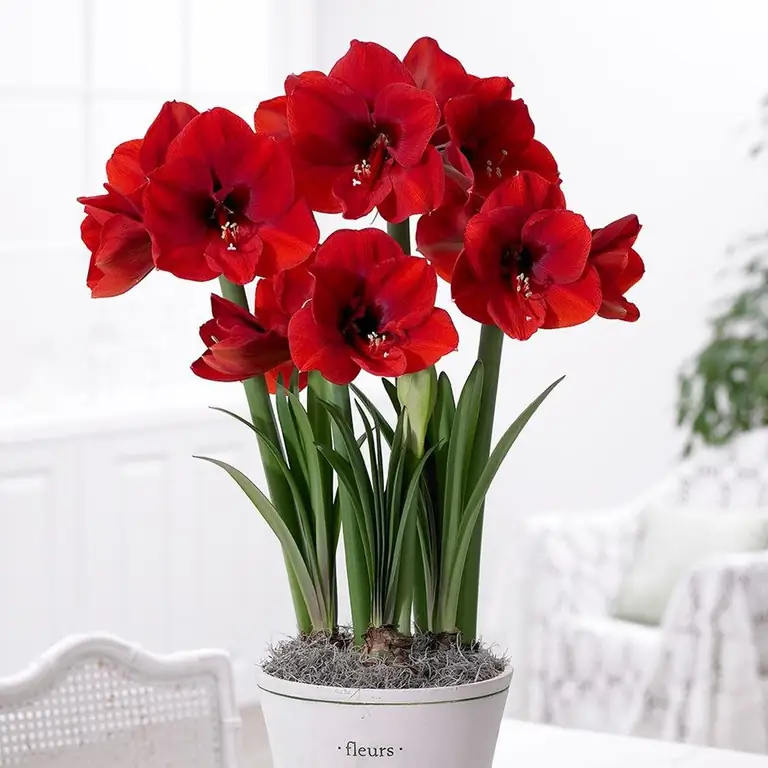
Description
Amaryllis is a bulbous perennial plant that came to us from South Africa. Its dark green belt-shaped leaves reach up to 70 cm in length. But of particular value to the plant are large buds located on a long peduncle, and up to 6 flowers can form on each of them. They reach up to 12 cm in diameter and have six petals with pointed tips. As a rule, the plant pleases with buds once a year - in September. But if you wish, you canachieve flowering two or even three times a year.
There are varieties with different bud colors. But amaryllis with red flowers is especially popular. A home flower with bright petals attracts attention and becomes an adornment of a plant collection. And if you want to grow a similar beauty, then choose these varieties:
- Red lion.
- Barbados.
- Ferrari.
- Grand Diva.
- Double Dragon.
Preparing for landing
In order for red amaryllis not to disappoint you, it is first of all important to purchase he althy bulbs. They should be dry and tight, without borders and any stains. Also note that he althy bulbs should be fairly heavy and firm. Also, do not purchase material that emits an unpleasant sweet smell.

You can grow these flowers in pots, flowerpots and even containers. But at the same time, it is advisable to choose heavy clay flowerpots that are not covered with enamel. As for the soil, you can buy it at the store or make it yourself. In the latter case, mix the following ingredients in equal parts:
- garden soil;
- soddy soil;
- peat;
- humus;
- river sand.
Be sure to disinfect the substrate before planting, even if you bought it in a store. To do this, hold the earth mixture over steam or bake it in the oven. In addition, to grow red amaryllis, you will need drainage, such as expanded clay, gravel or pebbles, andalso washed river sand.
Boarding rules
Planting amaryllis is a simple process that even a novice grower can handle. The main thing is to adhere to the following algorithm:
- Peel off the black, brown and beige scales of the selected bulb so that it turns white or light green. Put the prepared planting material in a solution of potassium permanganate for half an hour. Dry the disinfected bulbs for 12 hours. If you notice any damage, then treat them with brilliant green or Fitosporin.
- Pour a 2cm layer of drainage into the bottom of the pot. And sprinkle it with sand on top.
- Place the bulb in the pot with the blunt end down. Fill the voids with soil so that a third of the bulb rises above the substrate.
- Compact the soil lightly and water it.
Keep planted bulbs on a bright windowsill. Until the plant takes root, water it very sparingly. When doing this, make sure that moisture does not get on the top of the bulb.
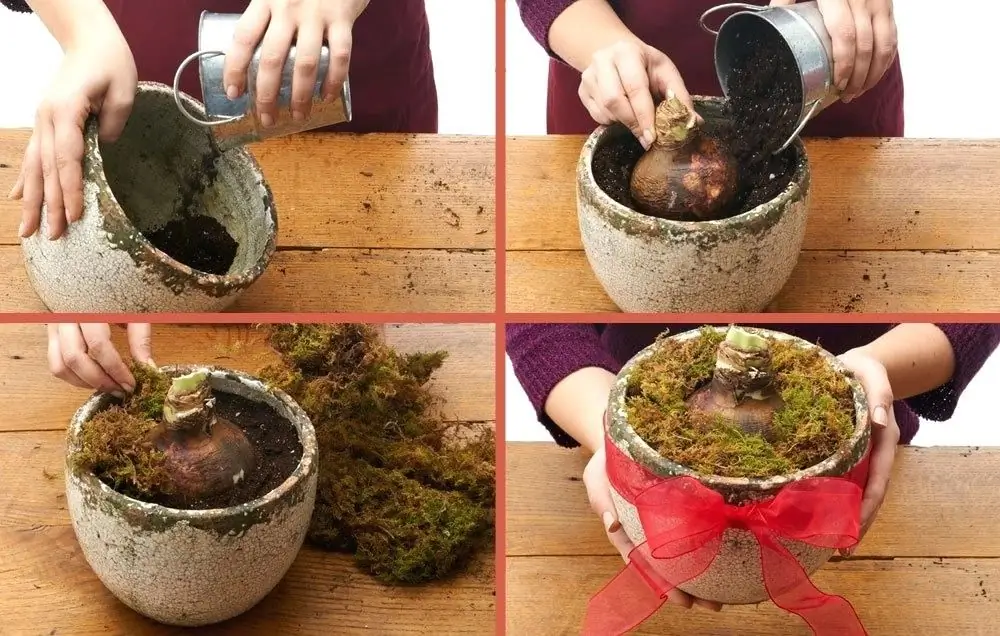
Features of care
Red amaryllis is an undemanding plant. And caring for it consists of the usual agrotechnical measures: regular watering, periodic feeding, transplanting, disease and pest prevention. In addition, it is important to provide the plant with a comfortable temperature, humidity and lighting, and then it can please the buds twice a year.
Remember that amaryllis bulbs are poisonous. Therefore, it is advisable to keep the flower in places not accessible to children and pets. In addition, you need to take care of the plant only with rubber gloves.
Lighting
Red amaryllis, the photo of which is given in the material, is a photophilous plant. But it is not recommended to keep it in direct sunlight for a long time. Therefore, it is better to grow a flower on an eastern or western windowsill. In extreme cases, you can place the pot near the south window. But then do not forget to shade the plant at noon, otherwise the leaves will get burned.
Amaryllis buds tend to droop over time. To avoid this, periodically turn the pot in different directions to the sun.
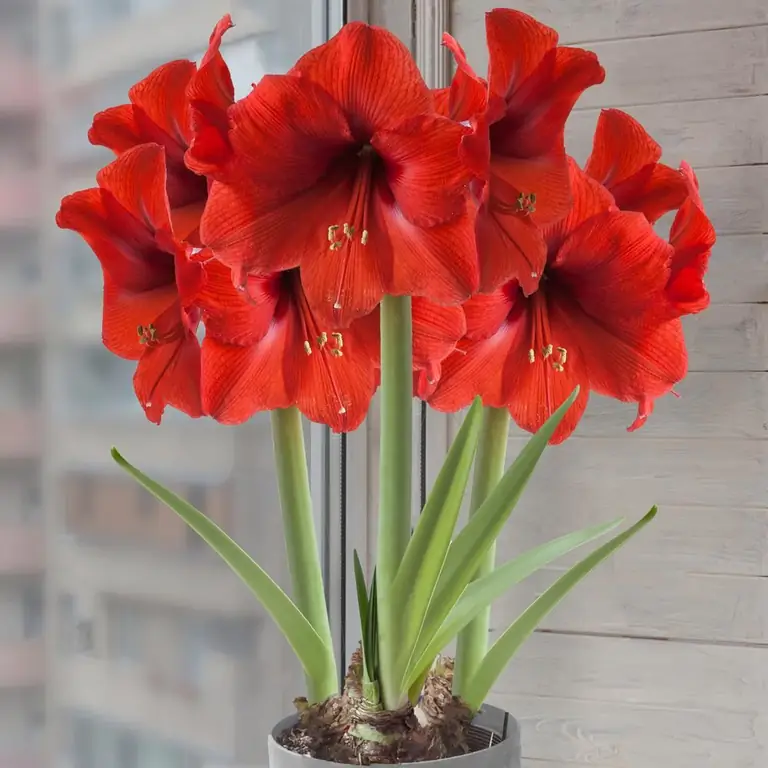
Temperature
When growing an amaryllis flower at home, try to keep the room temperature within + 18 + 25 ° C. After flowering during the dormant period, move the plant to a dark, dry location with cooler conditions. But make sure that the temperature does not fall below +10 ° C. Otherwise, the amaryllis will freeze and die.
Irrigation
When growing amaryllis at home, pay special attention to watering the flower. While the plant is just developing from the bulb, water it moderately, but do not let the earthy coma dry out. When the flower stem grows to a height of 10 cm, switch to more frequent and abundant irrigation (approximately once every three days). When watering, make sure that moisture does not get on the bulb, for this, try to pour water along the edges of the pot.
In winter, reduce watering to a minimum. At this time, it is enough to spray the soil near the bulbonce a week.
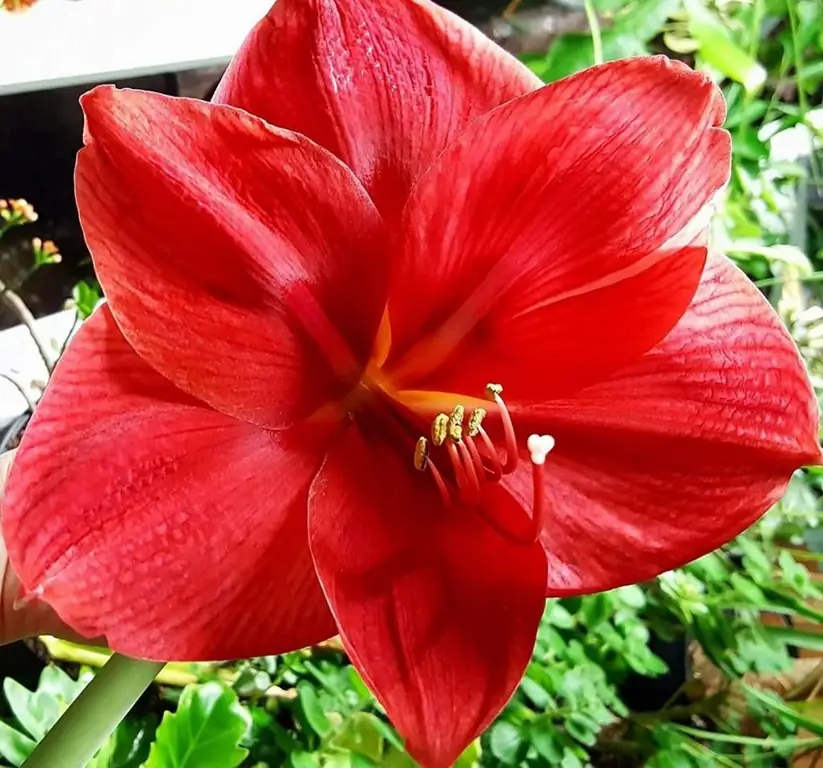
Feeding
Terry red amaryllis, however, like ordinary ones, need periodic feeding, because flower stalks draw a lot of energy from plants. Therefore, as soon as the budding begins, fertilize once every 14 days. During flowering, feed the amaryllis even more often, approximately once every 5-7 days.
Use fertilizers with a high content of potassium and phosphorus. Make sure that such dressings contain a minimum of nitrogen, because because of this substance the flower will increase its green mass to the detriment of the buds. You can also use organic fertilizers, such as a solution of manure or manure. During dormancy, the plant does not need to be fed.
Post-flowering care
Of course, you can make amaryllis bloom all year round. But such a regime will quickly deplete the strength of the plant, and it will die in a short time. So it is important to arrange a dormant period for the flower every year in winter. To do this, begin to gradually reduce the amount of watering and fertilizing, after the buds depart. In no case do not cut the leaves and peduncle, because from them the bulb will receive additional nutrients. Move the pot to a dark and cool place while you rest.
Transfer
With proper care, red amaryllis grows quickly and becomes cramped in an old pot. Therefore, experts recommend replanting a flower every 2-3 years. First of all, you need to choose the right pot for the plant. Please note that too large containers of amaryllis will notsuitable, since in this case it grows roots to the detriment of the buds. So choose with a diameter 2-3 cm larger than the size of the bulb itself. Give preference to narrow but deep flowerpots.

Start the event in July. Prepare the soil with the same composition as when planting (more on the substrate is described in the chapter "Preparing for planting"). During the event, be very careful not to damage the delicate roots and young leaves of the flower.
Growing from seeds
If you decide to grow a flower from seeds, then keep in mind that it is unlikely to retain varietal characteristics. In addition, such a plant will bloom only in the seventh year after planting.
To grow flowers, prepare a container and fill it with the substrate intended for seedlings. Moisten the soil and evenly distribute the seeds over its surface. Cover the crops with glass or polyethylene and put in a greenhouse in a bright and warm place where direct sunlight does not fall. Periodically ventilate the planting and spray the soil with warm water from a spray bottle. The first shoots will appear in 30 days, and after three months the seedlings can be transplanted into individual pots.
Reproduction by babies
This is the easiest and most popular way that even a beginner grower can handle. During a planned transplant, you can find babies on the mother's bulb. Carefully separate them with a sharp knife, plant them in individual pots in the same way as adult plants. And then give them their usual care. Such amaryllis will bloom in the second year after planting.
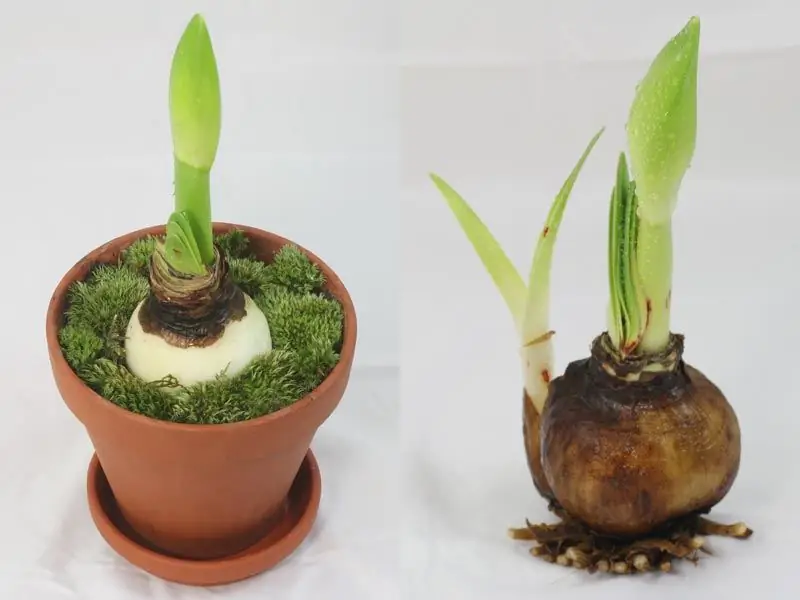
Diseases and pests
Mistakes in care greatly reduce the immunity of the plant. And then it can get sick and even die. Most often, the plant is affected by various rot. You can recognize such diseases by the appearance of gray, brown and reddish spots and stripes. As a rule, planting in contaminated soil or excessive watering leads to diseases. To cure the flower, reduce irrigation and treat the soil and the plant itself with a fungicide.
Amaryllis pests are often attacked by aphids and thrips. If you notice that the leaves of the flower began to turn yellow and deform, then carefully inspect the plant. And, having found pests, remove them with soapy water. Occasionally, amaryllis is affected by scale insects, spider mites and mealybugs. You can see these parasites with the naked eye. At the first sign of damage, treat the plant with any insecticide, such as Actellik. After spraying, it is advisable not to water the flower for a while.
Growing problems
If you provide proper care for the amaryllis flower at home, then there are practically no problems with your pet. But if you regularly violate agricultural technology, then the plant begins to act up. Most often, flower growers face such problems:
- The color of the buds has turned pale. This happens if you grow a flower in a too sunny place. Move the plant away from direct sunlight and it will restore color.
- The buds have darkened. This phenomenon occurs when growing intoo cold conditions. Move the flower to a warm room.
- The leaves turned pale and the buds drooped. So the plant reacts to the lack of water. Normalize watering, and amaryllis will restore beauty.
- The plant does not release buds. First of all, flower stalks do not appear unless you give the amaryllis a dormant period. And besides, buds may not appear when grown in depleted soil, too dark or cold place. And also the plant refuses to bloom if its bulb has been damaged by pests or diseases.
Delicate and bright amaryllis will decorate your collection of houseplants. To do this, it is enough to create comfortable conditions for him and adhere to the rules of cultivation. And then the plant will delight you with its buds for many years.






